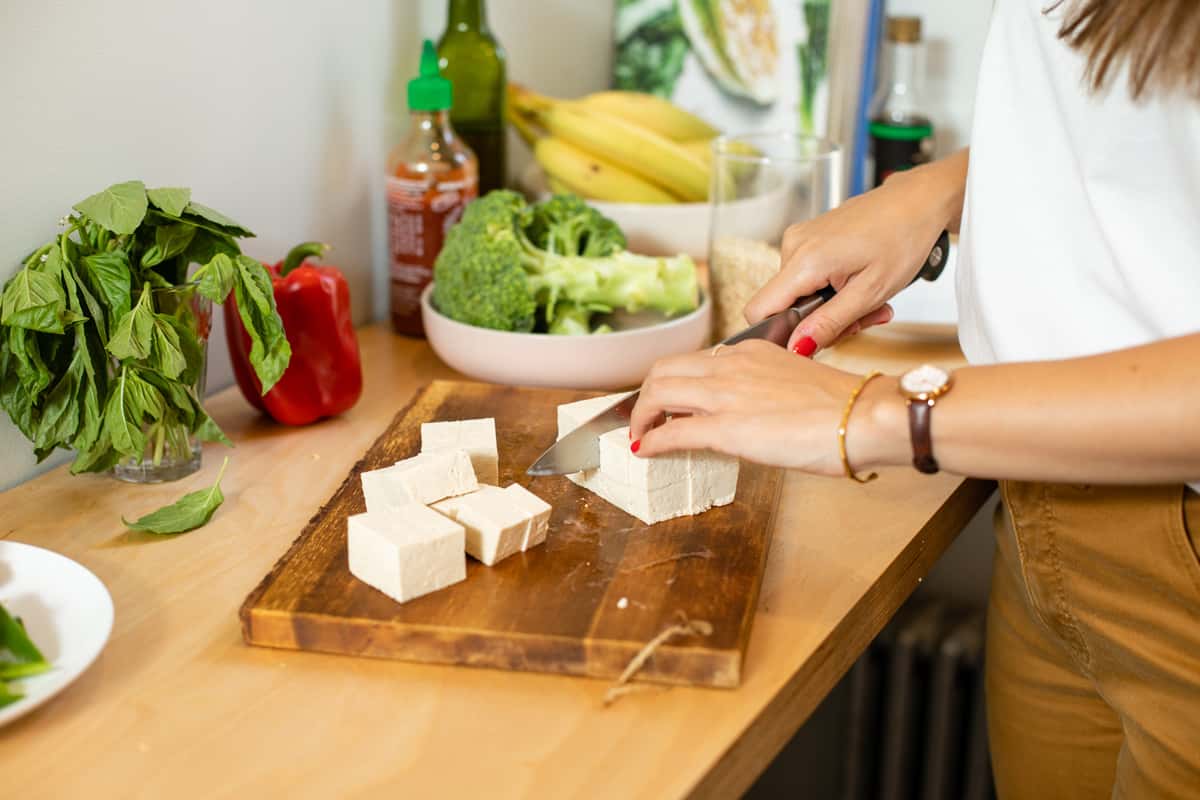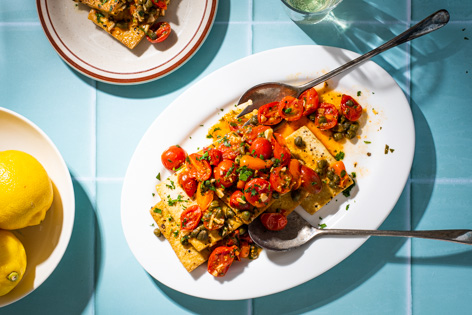Stocking your pantry with high-quality ingredients is the most proactive way to get yourself to cook delicious, healthy things on a regular basis. A thoughtfully-stocked pantry [or in the case of my Brooklyn kitchen, cabinet] is the proverbial net that’s there to catch when you fall… into a rut of Seamless orders, that is.
Here’s a list of things I always have on hand and recommend for you to invest in, too. Having these on standby means you’ll always be at least 50% ready to cook any of my recipes – the remaining 50% coming from vegetables, tofu/tempeh, fresh herbs, etc. I’m also including some examples of how I use these, as well my favorite brands.

Pasta, Noodles + Grains
Brown Rice: The staple of all staples! Short grain brown rice is waaay tastier than long grain – and it’s pleasantly chewy, too. I usually have a pot of cooked rice ready to go in the fridge for weeknight grain bowls and fried rice.
Pasta: Pasta gets a bad rap for being a simple carb, and I get that. But when you load it up with vegetables and other good-for-you things, it can be kinda healthy-ish, so I always keep a few boxes around. I don’t love whole wheat or alt pastas (chickpea, lentil, etc.) so I buy the classic white kind. Barilla Collezione is my go-to.
Rice Noodles: These quick-cooking Asian noodles are perfect for noodle salads and stir-fries, both of which are weeknight go-to’s for me. I get brown rice noodles whenever possible for extra nutrition.
Old-fashioned Rolled Oats: Apart from breakfast porridge, I also blend oats into smoothies (no need to precook them!), add them to pancake/waffle batter, and turn them into granola. They even make creamy mushroom soup!
Beans + Legumes
Beans: I always keep a few bags of dried white, black, or pinto beans, and cook them whenever I have extra time on the weekend. Cooking beans from scratch is more sustainable (i.e. no cans to recycle!), tastier, and healthier (less sodium, no additives). Throughout the week, I use pre-cooked beans for avocado-bean toast, refried beans, pasta, etc. In a hurry, canned beans work, too – just look for organic low sodium varieties.
Chickpeas: Much like beans, I love batch-cooking chickpeas and transforming them into curries, salads, and pastas. Again, canned chickpeas are obviously fine – look for organic low sodium varieties.
Lentils: Red lentils cook ridiculously quickly so I love to stock them for Indian lentil soup. Green lentils are another fave – I braise them in red wine, add them to veggie soups, or toss them into potato salad.
Nuts, Seeds + Nut/Seed Butters
Raw Cashews: These babies are the true MVP of a plant-based kitchen! They’re indispensable for making vegan bechamel, ricotta, caesar dressing, creamy dips, pesto, queso, and so much more.
Other Nuts + Seeds: Toasted nuts/seeds add crunch, protein, and healthy fats to many of my meals. These spiced pumpkin seeds, for instance, are always in my pantry, ready to be sprinkled on avocado toast, creamy soups, grain bowls, etc. Other favorites include: whole almonds, sliced almonds, and sunflower seeds. Hemp and chia seeds are both great nutrition boosters for smoothies and oatmeal.
Peanut Butter: God, I love this stuff… In smoothies, on oatmeal, in savory dishes like noodles, in peanut sauce, or just licked off a spoon. Be sure to buy the natural kind (the only ingredient should be peanuts and maybe salt) to avoid gross oils, unnecessary sugar, and other chemicals.
Tahini: a.k.a. sesame seed butter, this middle eastern ingredient makes the most delicious creamy dressings. Like peanut butter, the only ingredient should be sesame seeds. All tahini brands are slightly different so try a few to see which you like best.
Canned + Jarred Stuff
Coconut Milk: Next to cashews and tahini, canned coconut milk is the ingredient I turn to most often to add creaminess to things. It’s indispensable for curries and other soups/stews.
Canned Tomatoes: I stock diced and crushed tomatoes, and use them in everything from pasta and soups to veggie ragu. Look for organic low sodium varieties whenever possible.
Marinara: Pasta + random sauteed veg + marinara is a quick meal I make at least once a week. Store-bought marinara often has a ton of sugar so be sure to read the ingredients and buy a sugar-free variety whenever possible.
Panko: These Japanese-style breadcrumbs make the greatest crunchy topping for so many of my recipes, including eggplant lasagna stacks, stuffed portobellos, and even this cauliflower pasta.
Oils + Vinegars
Cooking Oils: For low-heat stovetop cooking, I use extra virgin olive oil. California Olive Ranch is an affordable, tasty, good-quality option; it also works in dressings. For higher-heat cooking and roasting, I opt for avocado oil or refined coconut oil (refined = no coconutty flavor). Despite its virtuous-sounding name, stay away from vegetable oil!
Toasted Sesame Oil: This finishing oil adds an amazing nutty flavor to everything from noodles to fried rice to dressings.
Unrefined Sunflower Oil: A Ukrainian staple, this oil has a rich, nutty flavor and is ideal for dressing all types of summer salads and most importantly, dill potatoes.
Vinegars: My 3 go-to’s are seasoned rice vinegar, balsamic, and red wine vinegar. Seasoned rice vinegar is super mild, sweet, salty, and tangy; it’s the ideal all-in-one pickling liquid and works perfectly in dressings. Balsamic is on standby for salads, and red wine vinegar is a mild-tasting option for brightening up everything from sauces to soups.
Flavor-Boosters
Sea Salt: I use fine sea salt for everyday cooking because it’s the least processed when compared to Kosher or iodized salt, and doesn’t have any additives. I also use coarse sea salt as a final touch on everything from avocado toast to tomato toast to all kinds of salads. I order both in bulk from Atlantic Spice Company.
Freshly Ground Black Pepper: It seems ridiculous to include pepper on this list, but it never ceases to amaze me how many people stoop down to using pre-ground pepper in that sad little store-bought tin! Freshly ground pepper is the easiest way to add a spicy, floral aroma to absolutely everything. Be an adult and buy yourself a pepper mill! I order these in bulk, too.
Soy Sauce: This salty-savory condiment is a key ingredient in so many of my dishes, from congee to vegan gravy. It adds depth and well-roundedness to anything you use it in. Be sure to look for an organic non-GMO version.
Yondu: A Korean staple, this fermented soy-vegetable concentrate is the easiest way to add that cooked-all-day taste to anything from rice to salads to sauteed greens. All you need is a tiny splash for major umami impact. (Save 20% if you buy directly from their website with code ALEX20).
Miso: This Japanese fermented soybean paste is another salty-savory favorite for enhancing umami. Just like soy sauce, be sure to buy an organic non-GMO one.
Capers: Sometimes referred to as “vegan anchovies”, these brined berries add a pop of salty tang to everything from potato salad to vegan caesar.
Red Curry Paste: A staple in Thai dishes, this chili paste is flavored with lemongrass, galangal (ginger’s close cousin), shallots, and spices. It’s an express train to spicy, savory, citrusy notes in things like curry, peanut sauce, and these addictive noodles.
Nutritional Yeast: Completely unrelated to baker’s yeast, these yellow flakes are essential to creating a “cheesy” flavor in lots of vegan things, like gratin and pasta. Lasts forever in the pantry.
Smoked Paprika: I haven’t done the math, but I’m pretty sure it’s in at least 70% of my recipes. This red spice adds a smoky flavor to everything from tempeh bacon to vegan bourguignon. Keep in mind that ground spices only stay fresh for about a year, so be sure to replenish your stock when needed.
Garlic Powder: In my book, it’s smoked paprika’s right-hand woman. I always use them together as an express train to savory smoky flavor.
Healthier Baking
Whole Wheat Pastry Flour: Think of WWPF as the all-purpose flour of health-minded bakers. Sometimes labeled “white whole wheat flour,” it’s milled from whole grains, which keeps all the grains’ nutrients intact (as opposed to AP flour, which is basically pure starch). Use WWPF in everything from banana bread to pancakes.
Raw Sugar: Although it’s still technically refined, raw/turbinado sugar is slightly less processed than white sugar.
Maple Syrup: As one of the least refined sweeteners out there, it’s my go-to for dressings, sauces, and marinades.
Unrefined [Virgin] Coconut Oil: I adore coconut flavor so I use it in almost all my baked goods, to cook pancakes and French toast, and whenever a typical baking recipe calls for melted butter (1:1 replacement). If you don’t like the flavor, use refined coconut oil. Always look for organic and “cold-pressed” on the label.
Flaxseed Meal: Ground flax seeds make the perfect vegan egg replacement (1 egg = 1 Tbsp flax meal + 3 Tbsp water). I use “flax eggs” in everything from pancakes to cookies.
Medjool Dates: The best way to sweeten things if you’re avoiding refined sweeteners. They’re not that versatile, but work well in things like energy balls and fudgy date brownies. Plus, dates dipped in peanut butter make the best afternoon pick-me-up.

